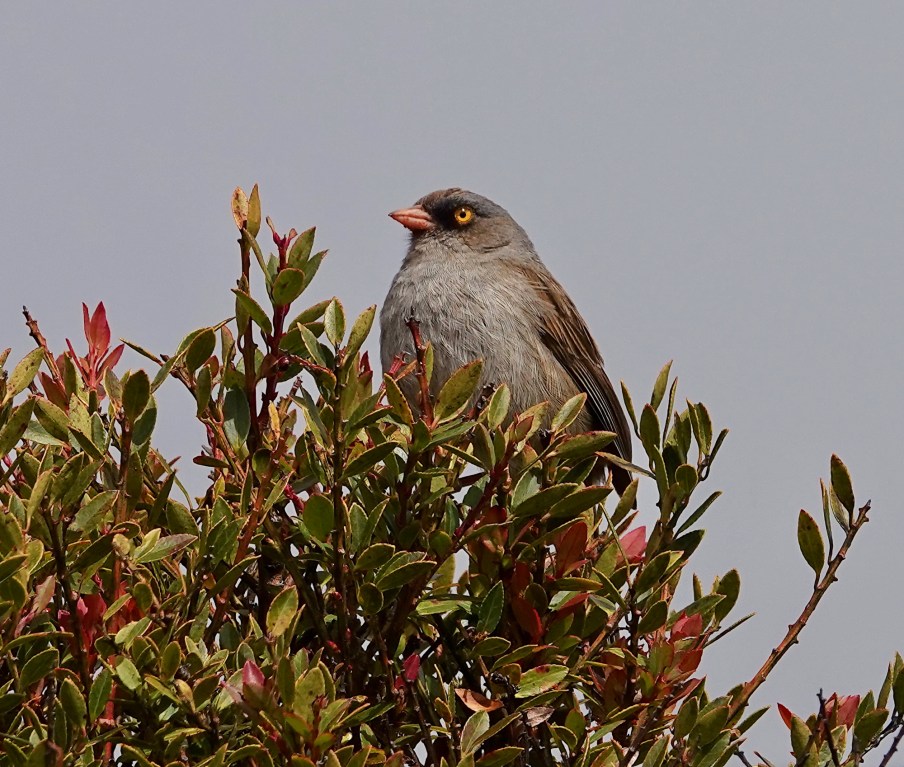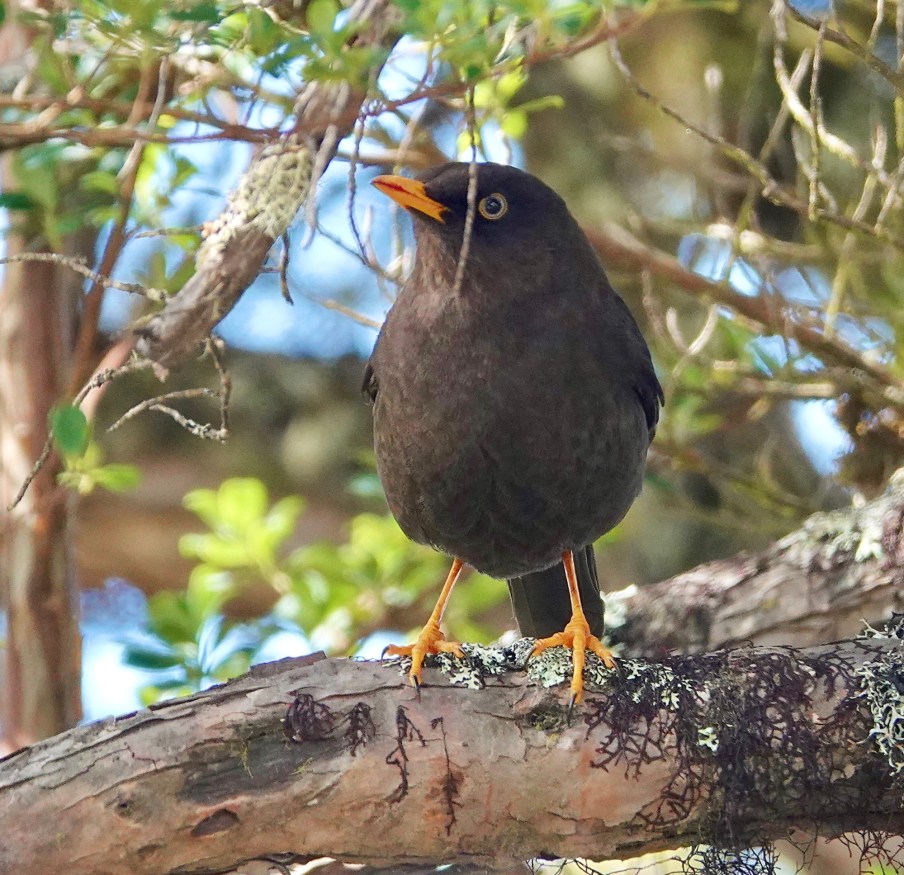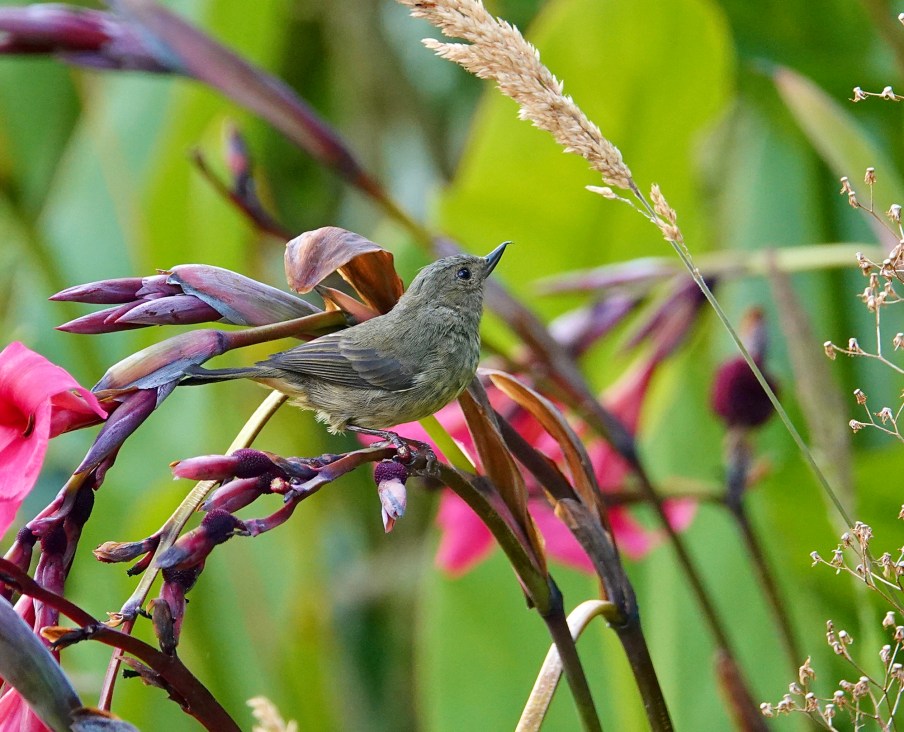Posts in Category: Costa Rica
Stripe-tailed Hummingbird


Stripe-tailed Hummingbird: Savergre Mountain Resort, San Geraldo de Dota, Costa Rica — This is another bird that is, in my opinion, “under-named.” I can think of so many more apt and flattering names than Stripe-tailed Hummingbird. And, honestly, the stripe on the tail is the last thing you are likely to notice about this bird. It’s “tell” (the memorable thing about it that is key to your recognition) is the rufous patch on the wings, and on the male, the bright green head and belly. It is not a common bird, but I generally see at least one on every trip to the Talamanca Mountains. This one was on the grounds of Savegre Mountain Resort. Sony Rx10iv at 547mm equivalent. Program mode with my custom birds and wildlife modifications. Processed in Pixelmator Photo and Apple Photos. ISO 640 and 1250 @ f4 @ 1/500th. +1 EV.
Volcano Hummingbird


Volcano Hummingbird: Cerro Buenavista, Talamanca Mountains, Costa Rica — I have seen Volcano Hummingbirds at lower elevations…down to about 8000 feet, but I found this one in its “native” habitat, above tree-line on the paramo of Cerro Buenavista at 11,400 feet, where there were quite a few around the parking area. I have to think they are pretty common at that elevation. The only other hummer that goes that high is the Fiery-throated, though the Fiery-throated is more common just below tree-line. The Volcano is a tiny hummingbird, half the size of a Fiery-throated, which is about the size of our Ruby-throated, and a quarter of the size of the Talamanca which it shares territory with in the Cloud Forests. Sony Rx10iv at 600mm equivalent. Program mode with my custom birds and wildlife modifications. For the second shot I had time to add some exposure compensation: +1…but after post processing it did not seem to matter. Processed in Pixelmator Photo and Apple Photos. ISO 160 and 125 @ f4 @ 1/500th.
Volcano Junco


Volcano Junco: Almost every birder who visits the paramo in Costa Rica wants to see the Volcano Junco, and not because it is the only Junco in Costa Rica. Mostly they want to see it because it is one of the few birds exclusively limited to the area above tree line, so its range in Costa Rica is very limited. It is not endemic to Costa Rica, but almost. You can see it on the highest peaks in Northern Panama, just over the border. Fortunately it is very easy to see (unlike the other iconic bird of the paramo, the Timberline Wren which can be very elusive). If you drive up to the top of Cerro Buenavista and park under the first antennas you are likely to see one as soon as you get out of the vehicle…feeding on the ground or in the bushes around the buildings there. There have been days when I have visited that were so bad…cold, windy, and misty, with a visibility of just a few yards…that the Volcano Junco was the only bird we saw on the paramo, but we have always seen at least a few. Sony Rx10iv at 320mm equivalent. Program mode with my custom birds and wildlife modifications. Processed in Pixelmator Photo and Apple Photos. ISO 100 @ f6.3 and 4.5 @ 1/1000th.
Sooty Thrush

Sooty Thrush: Cerro Buenavista, Talamanca Mountains, Costa Rica — Cerro Buenavista at 11,453 feet, is not the tallest mountain in Costa Rica, but it might well be the tallest you can drive to the top of. It is just off the Pan-Am Highway south of Los Quetzales National Park and the turn down into San Geraldo de Dota and its lodges. There is an array of antennas on top of the mountain, and the service road gives about the best access to the Paramo you could want. It is a regular stop on my trips to the Costa Rica, and I am sure, on many other birding trips as well. The Sooty Thrush is not restricted to the paramo (the short grass, bamboo, and shrub habitat above tree-line in the tropics) but it is common there (and down as low as the lower edge of the humid (cloud) forest). This one was waiting for us when we hopped out of the bus for our first “scenery” break on the mountain. On a clear day, you can see both the Caribbean and the Pacific from the top of Buenavista, and of course it is the place to look for Paramo speciality species like the Volcano Junco and Timberline Wren. Not that we were not delighted with our first bird there! Sony Rx10iv at 600mm equivalent. Program mode with my custom birds and wildlife modifications. Processed in Pixelmator Photo and Apple Photos. ISO 640 @ f4 @ 1/500th.
A tale of three male Quetzals



Resplendent Quetzal: San Geraldo de Dota, Costa Rica — The Resplendent Quetzal is, of course, the main attraction in the highland forests of Costa Rica. It is a stunning, relatively large, and almost impossibly beautiful, bird. Everyone wants to see it, and those who have seen one, want to see another. On our first December trip to Costa Rica last year, on our first morning in the mountains, we were up at 5 am, and on the bus by 5:30, for our first try at a Quetzal. We saw one. A single male flew into the wild avocado tree where it had been feeding at the time, and sat for maybe 5 minutes, just at dawn. Then it flew off, and did not re-appear in the time we had before breakfast at 7:30. Enough to say we had seen it, but not enough to satisfy. So on the second morning in the mountains, we were up again and on the road even earlier. The wild avocado trees do not all flower and fruit at the same time. Generally there will be only a few trees in the Savegre Valley in fruit on any given day, so finding the Quetzals is a matter of knowing which trees have fruit. A fruiting tree, if it is along the road where it is easy to get to, can attract 100s of birders and tourists from the lodges all up and down the valley each morning who are eager to see the Quetzal. It is also a waiting game. If you get there early you wait for the first bird to fly in. If you leave right after that, you take the chance of missing the real show. Our guide insisted that we wait, and indeed, as the sun crept down the slopes above us, two more male Quetzals flew in. It might have been hard to tell that we were seeing three different birds, but each of these males had different length “tail streamers” (the tail streamers are actually coverts…normally small feathers that grow from and cover the base of the true tail). Male Quetzals lose the covert streamers during nesting season as they fly into and out of the cavity nest, tending young, and have to grow them out each year, so the length of the streamers is a good indication of how recently the birds have nested. These three were clearly on different nesting cycles. Long, medium, and short. Sony Rx10iv at 600mm equivalent. Program mode with wildlife modifications and multi-frame noise reductions. Processed in Pixelmator Photo and Apple Photos. Equivalent ISO 6400 and 5000 @ f4 @ 1/500th.
Chlorophonia

Golden-browed Chlorophonia: Batsu Gardens, San Geraldo de Dota, Costa Rica — I may have told this story before, but on our first trip to Costa Rica this past December, we had a glimpse of a Golden-browed Chlorophonia, wee and far, in the canopy while hiking, and I, somewhat rashly, promised Dave (an avid birder and bird photographer) that I would show him one close up the next day when we visited Batsu Gardens on the mountain side above Savegre Resort. When we got in the van that takes you up to the gardens, I asked the owner if the Chlorophonia was coming to the feeders, and he said, “Some days”. Hum. So we sat there on the viewing platform all afternoon, watching and photographing hummingbirds, tanagers, finches, and toucanets. We were beginning to lose the light, and Dave had wandered off looking for photo-ops in the larger garden. I was beginning to think I was going to have to eat my words. And then suddenly, the Golden-browed Chlorophonia was there on the feeding station. Dave. Dave. DAVE! Chlorophonia. CHLOROPHONIA! I finally yelled. Dave came. We saw the Chlorophonia. We photographed the Chlorophonia. Whew. Close one. On the next trip I did not promise anyone anything, but we did see the Golden-browed Chlorophonia at Batsu again. And it is certainly a bird worth seeing. Such a bright little bird and such a striking color combination. Sony Rx10iv at 600mm equivalent. Program mode with my custom birds and wildlife modifications. Processed in Pixelmator Photo and Apple Photos and assembled in FrameMagic. ISO 640 @ f4 @ 1/500th.
Scintillant Hummingbird

Scintillant Hummingbird: Batsu Gardens, San Geraldo de Dota, Costa Rica — there are two tiny hummingbirds in Costa Rica. Both are birds of the highlands and their ranges overlap in the Talamanca Mountains. You can see them both at Batsu Gardens above San Geraldo de Dota. The Scintillant is just slightly larger than the Volcano, but not enough to notice. In the right light the gorgets on the males are very different. Bright orange-red on the Scintillant and a deep purple on the Volcano (the color of the Volcano’s gorget varies from pinkish red on the central volcanos, through the violet seen at Batsu, to greenish near the Panamanian border). Both birds are hard to catch perched, especially if you want to see the gorget flash. These flight shots show some of the color of the Scintillant male. Sony Rx10iv at 595mm equivalent. Program mode with my custom birds and wildlife modifications. Processed in Pixelmator Photo and Apple Photos and assembled in FrameMagic. ISO 400 @ f4 @ 1/500th.
Migrants


Western Tanager and Rose-breasted Grosbeak: Batsu Gardens, San Geraldo de Dota, Costa Rica — Of course a fair number of the birds you see in Costa Rica in December are wintering migrants who nest in North America…our birds of the forest and edges. There are many warblers, and they can be among the most common birds you see in the lowland and foothills. I have seen way more Wilson’s Warblers in Costa Rica than I have ever seen in North America. These two larger passerines were high in the mountains at Batsu Gardens, mixed in with the tropical specialties of the cloud forest. Both are typical of the winter plumage of birds that we see in more colorful plumage here in the US. The Western Tanager, as its name suggests, is limited to the western third of the US and Canada, while the Grosbeak is pretty much restricted to the eastern two-thirds. There are limited areas, in Canada mostly, where you might see both birds in the same location. They coexist nicely on the Pacific Slope of Costa Rica in winter, neither in large numbers…but they can be seen, as we saw them at Batsu, in the same place at the same time. Sony Rx10iv at 600mm equivalent. Program mode with my custom birds and wildlife modifications. Processed in Pixelmator Photo and Apple Photos. Tanager ISO 800 @ f4 @ 1/500th. Grosbeak ISO 400 @ f4 @ 1/500th.
Flame-colored Tanager


Flame-colored Tanager: Batsu Gardens, San Gerardo de Dota, Costa Rica — Tropical tanagers are among the most colorful songbirds…covering pretty much the full spectrum from deep red to brightest blue (sometimes in the same bird). The Flame-colored Tanger is relatively plane by that standard, though it can cover the full spectrum of orange pretty well. It is the typical highlands Tanager…it’s only rival for numbers at the elevations where you see it is the Blue-grey Tanager (and that you can see from sea-level to the highest peaks). This specimen was around the feeders at Batsu Gardens. Batsu is a project of one of the grandsons of the original settlers of the deep Savegre River Valley on the western slopes of the Talamanca Mountains. The Chacon family, two brothers and their wives and children, homesteaded the San Geraldo de Dota region in the 1950s, and as the family grew and more settlers were attracted to the valley, pioneered efforts to balance development with a healthy and rich environment. Eventually, 40 years later, they built the first cabins and lodge to accommodate birders, fishermen, and other tourists who were attracted to this beautiful area. Batsu Gardens, high on the mountain side, over 500 feet above the original lodge and the river, provides birders and photographers with covered viewing platforms, toilets, a coffee station, abundant native plantings, and responsibly managed feeders for the area birds. If you love birds, Batsu is one of the best places in Costa Rica to spend a morning or afternoon. Flame-colored Tanager is almost guaranteed 🙂 Sony Rx10iv at 600mm equivalent. Program mode with my custom birds and wildlife modifications. Processed in Pixelmator Photo and Apple Photos. ISO 640 and 1250 @ f4 @ 1/500th.
Slaty Fowerpiercer



Slaty Flowerpiercer: Batsu Gardens, San Geraldo de Dota, Costa Rica — There are 18 species of flowerpiercers, most in the highlands of South America. Two reach Central America, but only one is found in Costa Rica: the Slaty Flowerpiercer. All have the adapted beak that allows them to draw nectar from the base of flowers by making a small hole and sucking it out. They are common wherever there are masses of flowers at high elevations, so are often seen in gardens and the landscaped grounds around lodges. Here we have two close shots of the female and one, taken from a good distance, of the male. Sony Rx10iv at 600mm equivalent. Program mode with my custom birds and wildlife modifications. Processed in Pixelmator Photo and Apple Photos. ISO 640 and 800 @ f4 @ 1/500th.